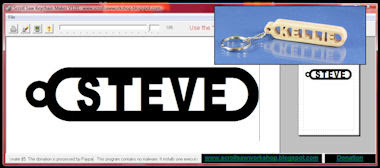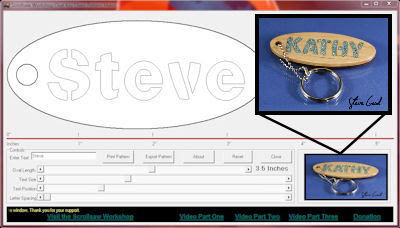SHARK!!!!! This guy is over 14 inches long.
There are around 440 shark species. The first sharks appeared in oceans over 400 million years ago.
They range in length from ~6.5 inches to 40 feet. The whale shark can weigh up to 13 tons. On average they swim a little over 3 mpg but can reach speeds in excess of 50mph. You are not going to outswim a shark. In the wild sharks have a lifespan of 20 to 30 years.
Sharks even have their own week. Shark Week on the Discovery Channel premiered in 1988. It was created by Tom Golden and features shark-based programming. I guess they deserve their own tv show since they are 400 million years old as a species.

What size scroll saw blade should I use?
You will sometimes see charts like the one above that tell you the appropriate blade to use for a certain thickness of the wood. Let me tell you my opinion on how to use these charts.
These charts tell you how efficient a blade will cut for a thickness of wood. If you are going to cut a board in half then the blade suggested will probably be the best choice. The blade will most efficiently remove the sawdust from the kerf and generate the least amount of heat while cutting the board at a fairly fast rate.
The problem is that we rarely use the scroll saw to do a crosscut or a rip cut. We are typically doing fretwork with small interior cuts and tight turns. Trying to make a tight turn with a #10 blade is just not going to happen. Because of this, we will not use a #10 blade even if the wood is one inch thick.
We will choose the blade based on the pattern. If my board is one inch thick but the pattern has small interior cuts I may select a #5 or even a #3 blade if I think that will let me cut the pattern with more accuracy.
The tradeoff is that the smaller blade will not be as efficient cutting the thicker board. I will have to slow my cut to allow the blade to remove the sawdust from the kerf. If I push the blade it will heat up and probably break.
There are times when choosing a smaller blade just won't work. Sometimes the species of wood is just too hard and you need a larger blade with fewer teeth per inch. In that case, the tradeoff is accuracy.
As you can see choosing the correct blade requires more information than is included in a chart.
Very few scroll saw artists who use their machine for fretwork ever use a blade larger than a #5. I am not saying that the larger blade do not have their place but it is generally for basic cuts.
All I have talked about in the above paragraphs is the size of the blade. This does not take into account the different styles of blade. That's another subject for another article.
North Easter Ohio Scroll Saw & Woodworking Expo:
I will be heading out this morning to go to the Ohio Scroll Saw Expo. I will have access to my email but I may be even slower than normal answering.

Email Newsletter Readers: Remember that the Newsletter is just a copy of the daily blog post. To see the post in it's proper formatting click this link. If you ever misplace a pattern or any item you see here you can always find it on the blog. Everything stays on the blog forever.
Scroll Saw Pattern Design Tutorial: DVD
Let me teach you to create a beautiful wooden portrait pattern. I will show you everything you need from start to finish. The video will show you the free software program you can download for Windows or Mac OS. I will show you how to install the program and configure it for best results.
Let me teach you to create a beautiful wooden portrait pattern. I will show you everything you need from start to finish. The video will show you the free software program you can download for Windows or Mac OS. I will show you how to install the program and configure it for best results.
Then I will show you the technique to take your photograph and make a pattern from it. When the pattern is complete we will go in the shop and cut it.
The DVD is $10 plus shipping. This is a data DVD that you will use on your computer to watch the video tutorial
Every Scrollsaw Workshop Pattern from 2007-2017 in DVD
Purchase the entire Scrollsaw Workshop pattern catalog for offline access.
This DVD has 2,300 patterns published from 2007 thru 2017.
The DVD is $20 plus shipping. Ships to 60 countries around the world.
The DVD is $20 plus shipping. Ships to 60 countries around the world.
If you use the DVD on a Windows PC there is a simple viewer program to browse through the patterns.
The DVD also works fine on a MAC. The viewer program is not MAC compatible but there is an included PDF with all the patterns shown as thumbnails for easy viewing.
My two "Wooden Vases on the Scroll Saw" books make it easy.
The books are $12 each and available for instant download after purchase. Click for Video Demonstration.
My Sponsors:
Support the businesses who support our community.
Home of Pegas scroll saw blades.
 Ad: Affiliate
Ad: AffiliateRikon 10-305 Bandsaw With Fence, 10-Inch Amazon Price $299.99 & Free Shipping.
- Solid Steel Design- The 10-305 is a scaled down version of the popular 10-345 and 10-325. Frame is made of steel plate, stronger than plastic frames used by other manufactures
- Cast Iron Table-Large 13-3/4-Inch by 12-1/2-Inch sturdy work surface, a feature not typically found on a bandsaw of this size
- Rip Fence- A quality rip fence is now included. Easily removed to do free hand work
- Motor - 1/3HP motor provides ample power for cutting bowl and pen blanks
- Micro Adjustable Guide Post- Raise and lower the guide post height with the turn of a handle







































